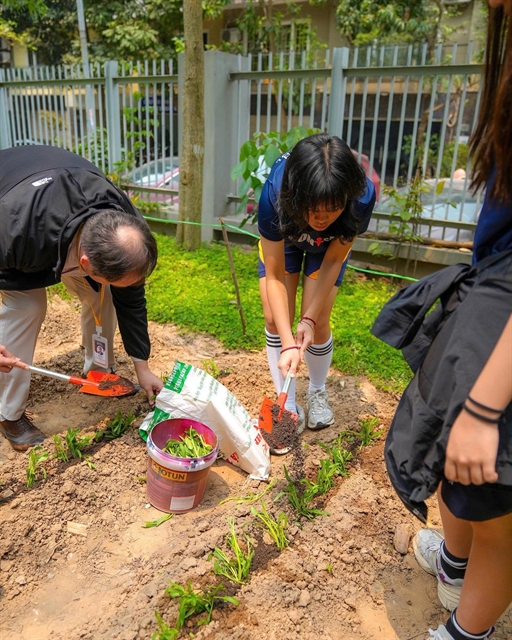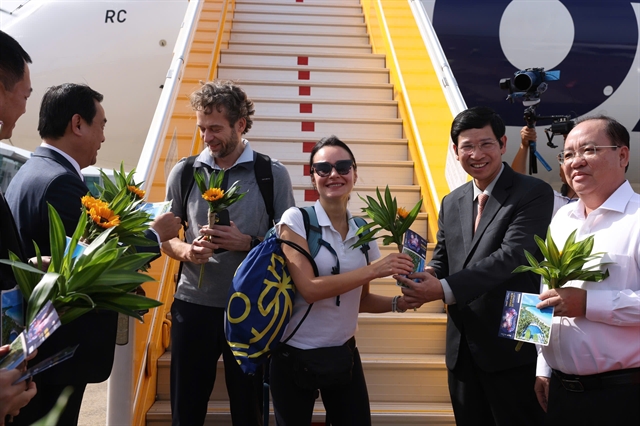 Environment
Environment

 |
| A bird in the Vân Long Lagoon in Gia Viễn District, the northern province of Ninh Bình. — VNA/VNS Photo Minh Đức |
HÀ NỘI — Việt Nam is promoting conservation activities at national, local and community levels as well as participating in the global Convention on Biological Diversity as a response to the United Nations’ call for a 'Decade on Ecosystem Restoration'.
Abundant life and rich potential
According to the United Nations Development Programme, Việt Nam is one of the countries with the highest level of biodiversity in the world with many different ecosystems, including mountains, tropical forests, limestone mountains, marine and coastal environments.
More than 100 bird species and more than 10 per cent of the country's plant species are endemic.
According to statistics from the Department of Nature Conservation and Biodiversity (DNCB) under the Ministry of Natural Resources and Environment, Việt Nam has three popular ecosystem groups including inland wetlands, coastal wetlands and marine.
A unique terrain stretching from north to south and a long coastline create rich habitats for the country.
Hoàng Thị Thanh Nhàn, Deputy Director of the DNCB, says that by last year, Việt Nam had 178 nature reserves, including 34 national parks, 59 nature reserves, 23 species and habitat conservation areas and 62 landscape protection areas.
Việt Nam currently has nine Ramsar sites and 11 world biosphere reserves recognised by UNESCO.
It also has 12 ASEAN Heritage Gardens, the most in the region, and one international water bird migration area on the East Asian-Australasian Flyway Partnership (EAAFP).
In terms of flora and fauna, Việt Nam has about 62,600 identified species, including about 3,500 species of invertebrates and freshwater fish, 1,932 species of terrestrial vertebrates and over 11,000 species of marine creatures.
Việt Nam also has a diverse range of local crop and livestock genetic resources, with more than 6,000 rice varieties, about 800 crop species and about 887 livestock breeds.
Forest area is also increasing. In 1995, after Việt Nam joined the Convention on Biological Diversity, forest coverage in the country reached 28.2 per cent. Now it is 42.02 per cent.
Urgent duty
 |
| The Đầm Nại mangrove forest nature reserve in Ninh Hải District, Ninh Thuận southern province. — VNA/VNS Photo Nguyễn Thành |
Experts from the World Wide Fund for Nature Việt Nam (WWF Việt Nam) state that the value of Việt Nam's biodiversity has decreased.
Phạm Minh Thảo, Programme Development Director of the WWF Việt Nam, says that the value reduction in natural ecosystems greatly affects the supply chains of food, energy, infrastructure and logistics as well as people's lives.
A worrying phenomenon is 'empty forests', meaning there is still forest and forest cover, but no animals under the forest canopy — and species diversity is also down.
Decades of forest product overexploitation, unplanned conversion of land use purposes, illegal hunting and wildlife trade have left many plant and animal species threatened or at risk of extinction, including 28 per cent of mammal species, 10 per cent of bird species and 21 per cent of reptile and amphibian species.
According to the National Biodiversity Report 2021, despite conservation efforts, biodiversity degradation and loss trends are still taking place in all types of ecosystems.
Thảo says that the causes of biodiversity loss in Việt Nam are mainly due to population growth and the pressure of land use conversion.
In addition, excessive and illegal exploitation of natural resources and illegal trade in biological resources, wild species and their products, as well as environmental pollution and the impact of global climate change have also contributed to the problem.
Management policy and the legal system also lack synchronisation, leading to low effectiveness.
Finally, awareness about biodiversity conservation is still limited at all levels and sectors.
Typical example
Quảng Nam central province has recently become a shining example in the country for efforts to preserve and restore ecosystems, wild species, and rare genetic resources.
With a large area that includes many different habitats, Quảng Nam is classified as a locality with high biodiversity.
Currently, the province has eight established conservation areas, including a part of the Bạch Mã National Park, the Sông Thanh National Park, the Sao La Species and Habitat Conservation Area, the Voi Species and Habitat Conservation Area, the Ngọc Linh Nature Reserve, the Mỹ Sơn Cultural and Historical Landscape Protection Area, the Cù Lao Chàm Marine Reserve and the Bà Nà Núi Chúa Nature Reserve.
In 2020, Quảng Nam founded the Sông Thanh National Park, the province's first national park and one of the largest special-use forests in Việt Nam.
The park has a total area of more than 76,000 hectares, spread over 12 communes in Nam Giang and Phước Sơn districts. Of these, 58,220ha are within the strictly protected area, with all forest resources and forest land intact. More than 18,360ha belong to the ecological restoration subdivision with the function of protecting landscape and forest resources.
According to Hồ Quang Bửu, Deputy Chairman of the Quảng Nam People's Committee, the Sông Thanh National Park is not only important for conservation but also has a positive impact on the province's socio-economic development, promoting active protection for tropical forest ecosystems and rare animal species in the region.
The province’s determination to conserve nature is also expressed in many programmes and policies, including the Nature and Biodiversity Conservation Plan for 2021-2030, with a vision to 2025.
Consistent with conservation goals
The Prime Minister has approved the National Strategy on Biodiversity to 2030, with a vision to 2050.
In this plan, the main priority is to improve policies and laws and strengthen conservation capacity.
The policy and legal system will be reviewed to ensure consistency, and requirements will be updated to implement national and international commitments and practices.
The strategy aims to enhance the capacity of organisations and people working on biodiversity conservation from central to local levels.
It focuses on raising awareness about nature and biodiversity conservation, including responsible lifestyles and living in harmony with nature, at all levels of society.
Integration of biodiversity conservation requirements in policy planning and public investment projects, along with scientific research and advanced technology application in conservation and sustainability will also be supported in the plan.
The Government has also issued a project on strengthening prevention of biodiversity crimes with an aim of creating strong changes in biodiversity laws.
Specialised agencies are urgently completing and amending relevant contents in Decree No 08/2022/NĐ-CP and Circular No 02/2022/TT-BTNMT on detailed guidance for the Law on Environmental Protection. They include content on biodiversity impact assessment, natural heritage environmental protection and management plans.
This year, the DNCB will assess 15 years of conducting the Law on Biodiversity 2008, creating a premise for amending the law in the direction of ensuring unified state management in accordance with practical conditions, domestic and international context.
Deputy Director Nhàn says that Việt Nam has joined many international treaties related to nature conservation and biodiversity such as the Convention Concerning the Protection of the World Cultural and Natural Heritage in 1987, the Convention on Biological Diversity in 1994, the Ramsar Convention in 1989 and the Convention on International Trade in Endangered Species of Wild Fauna and Flora in 1994.
Việt Nam is also working to realise the goals of the Kunming-Montreal Global Biodiversity Framework (GBF) adopted at the 15th Conference of the Parties to the Convention on Biological Diversity held in December 2022 in Montreal in Canada. — VNS




